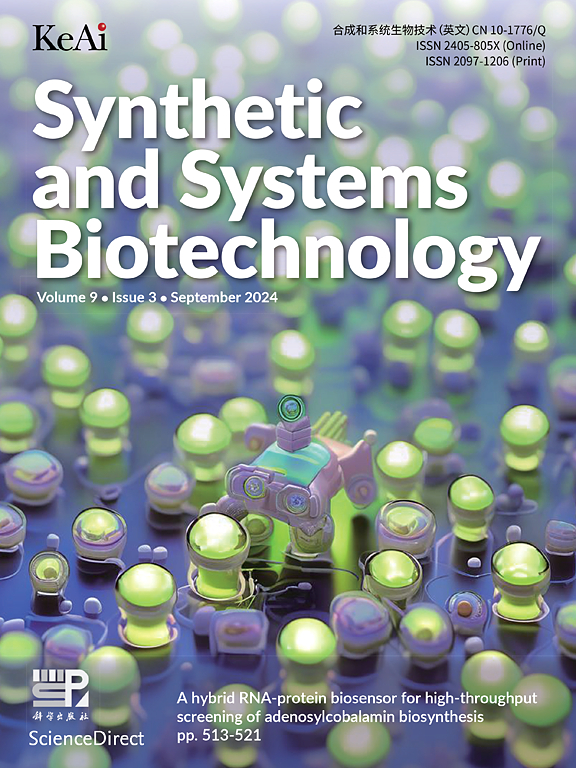Robust production of N-acetyl-glucosamine in engineered Escherichia coli from glycerol-glucose mixture
IF 4.4
2区 生物学
Q1 BIOTECHNOLOGY & APPLIED MICROBIOLOGY
引用次数: 0
Abstract
Achieving a balanced cell growth and biosynthesis of target products is a pivotal challenge confronted in the realm of green biomanufacturing of chemicals, and it holds the promise of significantly enhancing the titer/yield/productivity of the target products. The co-utilization of carbon sources has emerged as a proven approach for the precise regulation of cell growth and biosynthesis processes, thereby serving as a potent strategy to expedite the production of chemicals. In our previous study, we successfully demonstrated the efficient production of N-acetyl-glucosamine in engineered Escherichia coli by leveraging an appropriate catabolic division of labor, utilizing a mixture of glycerol and glucose as the carbon source. In this study, we further refined the division of labor between these two carbon sources by meticulously regulating the expression of the zwf gene, which encodes glucose-6-phosphate dehydrogenase and is crucial in diverting carbon source to the pentose phosphate pathway (PPP). After comparing three strategies for balancing cell growth and production, the engineered strain NAG-1 with zwf knocked out aided by the optimization of the glycerol-to-glucose ratio and the feeding mode of carbon sources resulted in robust production of N-acetyl-glucosamine. Remarkable production in a 5 L bioreactor was achieved, obtaining 249 g/L of N-acetyl-glucosamine with a yield of 0.684 g/g of total carbon sources (specifically, 0.791 g/g of glucose) and a productivity of 3.46 g/L/h. These results establish NAG-1 as the most efficient microbial cell factory reported thus far for the bioproduction of N-acetyl-glucosamine. The robust production of N-acetyl-glucosamine in E. coli using a mixture of glycerol and glucose suggests the immense potential of mixed carbon sources in the industrial green biomanufacturing of chemicals.
在工程大肠杆菌中从甘油-葡萄糖混合物中稳健生产n -乙酰氨基葡萄糖
实现目标产物的细胞生长和生物合成的平衡是化学绿色生物制造领域面临的关键挑战,它有望显著提高目标产物的滴度/产量/生产力。碳源的共同利用已成为精确调节细胞生长和生物合成过程的一种行之有效的方法,从而成为加速化学品生产的一种有效策略。在我们之前的研究中,我们利用甘油和葡萄糖的混合物作为碳源,利用适当的分解代谢分工,成功地证明了在工程大肠杆菌中高效生产n -乙酰氨基葡萄糖。在这项研究中,我们通过精心调节编码葡萄糖-6-磷酸脱氢酶的zwf基因的表达,进一步细化了这两种碳源之间的分工,zwf基因在将碳源转移到戊糖磷酸途径(PPP)中至关重要。在比较了三种平衡细胞生长和生产的策略后,通过优化甘油与葡萄糖的比例和碳源的喂养方式,敲除zwf的工程菌株NAG-1产生了大量的n -乙酰氨基葡萄糖。在5 L的生物反应器中,n -乙酰氨基葡萄糖的产率为249 g/L,总碳源产率为0.684 g/g(葡萄糖为0.791 g/g),产率为3.46 g/L/h。这些结果表明,NAG-1是迄今为止报道的生物生产n -乙酰氨基葡萄糖最有效的微生物细胞工厂。在大肠杆菌中使用甘油和葡萄糖的混合物稳健地生产n -乙酰氨基葡萄糖,这表明混合碳源在工业绿色生物化学制造中的巨大潜力。
本文章由计算机程序翻译,如有差异,请以英文原文为准。
求助全文
约1分钟内获得全文
求助全文
来源期刊

Synthetic and Systems Biotechnology
BIOTECHNOLOGY & APPLIED MICROBIOLOGY-
CiteScore
6.90
自引率
12.50%
发文量
90
审稿时长
67 days
期刊介绍:
Synthetic and Systems Biotechnology aims to promote the communication of original research in synthetic and systems biology, with strong emphasis on applications towards biotechnology. This journal is a quarterly peer-reviewed journal led by Editor-in-Chief Lixin Zhang. The journal publishes high-quality research; focusing on integrative approaches to enable the understanding and design of biological systems, and research to develop the application of systems and synthetic biology to natural systems. This journal will publish Articles, Short notes, Methods, Mini Reviews, Commentary and Conference reviews.
 求助内容:
求助内容: 应助结果提醒方式:
应助结果提醒方式:


